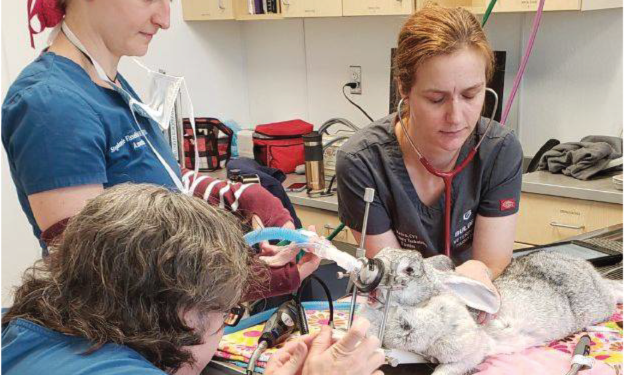Exotic Vet Technicians: What They Do

Written by: Mike Corcoran, DVM, DABVP (R/A), CertAqV
From October 13th through the 19th, veterinary hospitals celebrate National Veterinary Technician Week. I thought as a great follow-up to last month’s pet tales, What Do Exotic Animal Vets Do, I would talk about the job of a veterinary technician with a special focus on our tech in the exotics department: Karen!
Karen is an indispensable part of the team, providing excellent care to the pets in our care. Being a veterinary technician, especially in an exotics department, isn’t just cuddling cute animals. These are highly trained, highly skilled professionals similar to nurses in human medicine, but with some very significant differences. Let’s review the jobs covered by a veterinary technician:
Nurse
A nurse is the most obvious equivalent job in human medicine.
First, medications (oral or injectable) may be administered by veterinary technicians. Veterinary technicians must understand the medications being administered, the doses, and which are safe for different species. The veterinarian is always responsible for prescribing the doses, but technicians are the last last checkpoint, which is crucial to the patient’s safety.
When pets need to stay in the hospital for intensive treatment, technicians may also place IV catheters and monitor fluid administration. They will also be responsible for ensuring the pet has a suitably comfortable and clean cage at all times, monitoring appetite, measuring vital signs, and supplementing nutrition. An exotics technician must know the normal vital signs for all the species that we treat.
When medications and other treatments need to be administered at home, it’s normally a veterinary technician that will be teaching the pet parent how to continue care at home during the discharge or check out process.
Phlebotomist and Laboratory Technician
An exotics technician like Karen must be able to obtain blood samples safely from mammals, birds, reptiles and fish. This means understanding safe sites in all of those animals and knowing how much is safe to take from each of the animals. Many of our pets are too small to obtain the size blood sample that we use in dogs and cats. Being precise about getting the proper amount of blood from a safe location is vital to their health care. It’s also important to be able to do this while handling the pets using methods that minimize stress since we can’t explain to them what we are doing.
Once the samples are obtained, the blood must be handled properly. A veterinary technician can then prepare the sample for an outside lab or run the samples through our in-house lab machines to get more immediate results.
Nurse Anesthetist
This is one of the most complex roles for an exotic animal veterinary technician. Anesthesia involves administration of a variety of medications to allow deep sedation or a level of anesthesia for performing surgery. A delicate balance must be struck between having a deep enough anesthesia to allow a pain-free experience for the pet, but light enough to maintain normal blood pressure, heart rate and other vital signs for safety. This means continuous monitoring of vital signs, ensuring good flow of oxygen to the pet, controlling the body temperature and adjusting the dose of anesthesia based on that information and the type of procedure being done at the time.
Karen does this for birds, rabbits, guinea pigs, lizards, snakes, turtles, fish, hedgehogs and all the other animals that we treat in the department.
This is also an area that highlights the continuous development of knowledge and skills that is important to the profession. Karen has been working very closely with our anesthesiologist, Dr. Fissekis, to learn a variety of local and regional nerve blocks for animals that we anesthetize. Using these blocks with local anesthesia helps the pet be more comfortable during surgery and recovery from surgery. Perhaps more importantly, using these techniques means that the dose of other anesthesia drugs can be lowered, giving better control over temperature, blood pressure, respiration and heart rate. This makes anesthesia safer.
Pharmacy Technician
Most medications don’t come in a convenient form for exotic pets. Pills designed for humans, dogs, or cats usually don’t work well for very small creatures or for doses of animals that have a very different metabolism. Exotics require medications to be specially prepared.
When I prescribe a medication, Karen formulates that into a flavored liquid to be a more convenient and effective formulation for your pet. We have a full system in-house with tested and proven formulations from a company that provides the data and the ingredients to make medication easier and safer.
Radiology Technician
Advanced imaging, like radiographs (x-rays), ultrasound, and CT are very important for proper diagnosis of many conditions. It’s important for the pet to remain very still in a precise position to get good images. Sometimes this is done with sedation, other times it is done with a very calm approach, allowing the pet to relax and stay in a position that gives needed information while reducing stress to the pet and allowing them to be in a comfortable position.
Either way, the exotics technician must be an expert in handling and responding to behavioral cues from the pet to ensure the least stressful experience and the safest sedation while getting essential information that allows us to treat the underlying problem.
It’s my hope that these last two blogs can help give you a better understanding of everything that goes into making your pet feel better, be comfortable, and receive treatment. They are in excellent hands with our nursing staff when they need to go to the treatment area or stay in the hospital!